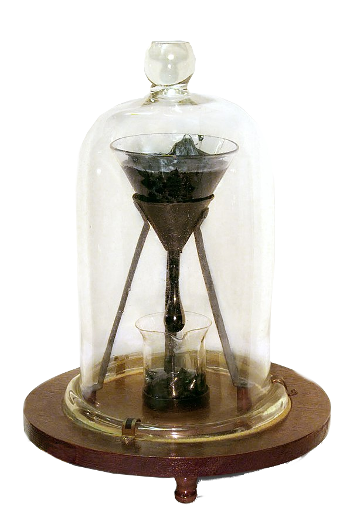Go with the Flow
July 8, 2019
There's a
scientific myth that
window glass is a
liquid, not a
solid. The "
proof" of this is that windows made during the
American colonial period are thicker at the bottom than at the top, as if the liquid glass has
flowed downwards over the
centuries. Windows of the much older
stained glass windows in
medieval churches are thicker at the bottom as well.

One of the stained glass rose windows of the Notre Dame cathedral in Paris during better days.
A fire on April 15, 2019, destroyed most of this church, but the three rose windows dating to the 13th century were undamaged.
The glass pieces in such windows are held together by lead channels. Lead melts at 621.43 °F (327.46 °C), and a hot wood fire can burn at 1000 °F (538 °C)
(Wikimedia Commons image by Rijinatwiki.)
All this makes a good
story, since today's glass window panes are exceedingly flat. Their flatness arises from the
process of manufacture, the
float glass technique in which the
soda-lime glass is
floated on a bath of
molten tin. This process was perfected in the
mid-20th century, but from the
mid-19th century glass was flattened between
hot rollers and then
polished. Before that time, glass was
blown into large
cylinders by traditional
glassworking techniques, then cut and flattened. This gave an uneven
cross-section, and workers would
instinctively mount
panes with the thicker end at the bottom.
Solid glass does not flow, but it is unlike most other solids, which are built from small
crystallites. Glass is a
non-crystalline,
amorphous solid. Other glassy materials exist beyond the
transparent window glass commonly known. These include
Amorphous metals, many of which have useful
magnetic properties, and a
glassy form of carbon, an extremely useful material. A distinguishing characteristic of glasses is the
glass-transition temperature below which
atomic movement nearly stops. However, at temperatures just below the glass-transition temperature the atoms will arrange themselves into a
crystal structure, but far below that the amorphous glassy structure is locked into place.
A 2013 study of
fossil amber by
chemical engineers at
Texas Tech University (Lubbock, Texas) reaffirmed the
conjecture that glass does not flow at
room temperature over long periods of time.[1] This
research looked at the
stress relaxation of a 20-million-year-old specimen of
Dominican amber at temperatures just above room temperature to its glass transition temperature. It was found that the atoms of this glass behaved as would be expected of a solid locked into place below the glass transition temperature and kept near room temperature for such an extended period of time.[1]
As is confirmed by everyone's experience with liquids from
water to
honey, some
materials flow faster than others, and the
rate of flow is temperature-dependent. As I wrote in an
earlier article (Rheometry, November 3, 2011)
scientists quantify flow rate with
instruments called
rheometers, and the
science of flow is called
rheology.
As early as the
5th century BC, the
Greek philosopher,
Heraclitus of Ephesus, observed that "everything flows" (
παντα ρει). The
Roman philosopher,
Lucretius (c. 99 BC - c. 55 BC), wrote about rheology in his book,
De Rerum Natura (On the Nature of Things).[2-3]

Lucretius wrote about rheology in his De Rerum Natura (On the Nature of Things), Book II, ll. 391-397.[2] The above excerpt reads in English translation as,"We see how quickly through a colander the wines will flow; how, on the other hand, the sluggish olive oil delays: no doubt, because 'tis wrought of elements more large, or else more crook'd and intertangled. Thus it comes that the primordials cannot be so suddenly sundered one from other, and seep, one through each several hole of anything."[3] (Created using Inkscape. Click for larger image.)
Isaac Newton (1642-1727), proposed a
theory of
viscosity, the resistance to flow, in his
Principia, where he writes, [4-5]
"Resistentiam, quae oritur ex defectu lubricitatis partium Fluidi, caeteris paribus, proportionalem esse velocitati, qua partes Fluidi separantur ab invicem."
"The resistance which arises from the lack of slipperiness of the parts of the liquid, other things being equal, is proportional to the velocity with which the parts of the liquid are separated from one another."
Viscosity is the scientific term for Newton's "lack of slipperiness."

The flow of a very high viscosity material, pitch, is illustrated in the University of Queensland Pitch Drop Experiment.
Hot pitch was poured into a funnel having a sealed end, where it was allowed to set for several years. The sealed end was broken, and the high viscosity pitch was allowed to flow into a beaker.
From 1930 until 2000, only eight drops of pitch flowed into the beaker, illustrating a viscosity that's about 230 billion times that of water at room temperature.
(Wikimedia Commons image, modified.)
In these cases of flow, the materials are actually flowing through another medium,
air, that we've ignored. Air does not appear to have any affect, since the
density of air, about a
milligram per
cubic centimeter is more than three
orders of magnitude less than that of these materials; so, it's as if these flows are in vacuum. However, when a dense fluid flows onto a fluid that's slightly less dense, such as water onto oil, the shape of the interface between the fluids distorts over time. Lobes of one liquid poke into the other in what's known as a
Rayleigh–Taylor instability, named after
John William Strutt, the 3rd Baron Rayleigh (1842-1919) and
Geoffrey Ingram Taylor (1886-1975).
There's a simple scientific explanation for the Rayleigh–Taylor instability. In
nature, a
system tends to arrange itself to
minimize energy. When
lobes of one fluid interpenetrate another and a
volume of a heavier fluid is pushed downwards and an equal volume of a lighter fluid is pushed upwards, the
potential energy of the system is reduced since these fluid masses are affected by
gravity. As Rayleigh found, the energy is further reduced as this interface disturbance grows under the influence of gravity, and Taylor generalized the action to
accelerations other than just
gravitational acceleration.
A team of
mechanical engineers at
Lehigh University (Bethlehem, Pennsylvania), led by
Arindam Banerjee, an
associate professor at
Lehigh's Department of mechanical engineering and mechanics, have investigated the
dynamics of fluids and other materials as they exhibit Rayleigh-Taylor instability under extreme accelerations.[6-7] Since things happen on a short timescale, not much is known about these conditions.[7]
The Lehigh team perfected their measurement
apparatus, a
vane-spindle rheometer, over the course of several years.[6-7] Their research involved the incompressible Rayleigh-Taylor instability in
elastic-plastic materials. Says Banerjee,
"There has been an ongoing debate in the scientific community about whether instability growth is a function of the initial conditions or a more local catastrophic process... Our experiments confirm the former conclusion: that interface growth is strongly dependent on the choice of initial conditions, such as amplitude and wavelength."[7]
The motivation for these studies is the understanding of two-fluid mixing at conditions relevant to those in
inertial confinement fusion.[7] Inertial confinement fusion is the
fusion of
hydrogen isotopes contained inside
centimeter-sized
metal spheres. These are excited by
high-powered lasers that
compress the
hydrogen gas to bring its temperature up to several million
kelvin to potentially cause fusion.[7] This process happens in just
nanoseconds, and the concept is that the melted metal compresses the gas. However, the mixing of the molten metal and gas creates a premature
explosion.[7]
In the Lehigh experiments,
mayonnaise is used as an elastic-plastic material whose properties are much like that of the molten metal.[6-7] Wave-like perturbations were formed on the mayonnaise before acceleration, and a high-speed
camera (500
frames/second) imaged the growth of the perturbations.[6-7]

Growth of the interface perturbation with time. (Lehigh University image by Arindam Banerjee)
It was found that the perturbations increased
exponentially with time after instability, and
three-dimensional interfaces were found to be more stable.[6] In these, and also
two-dimensional instability, a decrease in initial amplitude led to a more stable interface in which a higher acceleration was needed to generate the instability.[6-7] Aside from the implications to inertial confinement fusion, these findings are applicable also to
geophysics,
astrophysics, and
industrial processes such as
explosion welding.[7] This research was funded by the
Department of Energy,
Los Alamos National Laboratory and the
National Science Foundation.[7]
References:
- Jing Zhao, Sindee L. Simon, and Gregory B. McKenna, "Using 20-million-year-old amber to test the super-Arrhenius behaviour of glass-forming systems," Nature Communications, vol. 4, Article no. 1783, April 30, 2013, https://doi.org/10.1038/ncomms2809. This is an open access article with a PDF file available here.
- TITI LVCRETI CARI DE RERVM NATVRA LIBER SECVNDVS, Book II, ll. 391-397, Latin Text, via The Latin Library.com.
- Lucretius, "On the Nature of Things," Translated by William Ellery Leonard, Book II, ll. 391-397, via Classics.MIT.edu.
- Roger I. Tanner and Kenneth Walters, "Rheology: an historical perspective," Elsevier, 1998, 255 pages.
- I.S. Newton, "Philosophiae Naturalis Principia Mathematica," 1st Ed., 1687, Bk 2, Sect. IX, Latin text via Project Gutenberg.
- Rinosh Polavarapu, Pamela Roach, and Arindam Banerjee, "Rayleigh-Taylor-instability experiments with elastic-plastic materials," Phys. Rev. E, vol. 99, no. 5 (May 8, 2019), Article no. 053104, Rinosh Polavarapu, Pamela Roach, and Arindam Banerjee, "Rayleigh-Taylor-instability experiments with elastic-plastic materials," Phys. Rev. E, vol. 99, no. 5 (May 8, 2019), Article no. 053104.
- Lori Friedman, "Behold the Mayo: Researchers Reveal 'Instability Threshold' of Elastic-Plastic Material Using Hellmann's Real Mayonnaise," Lehigh University Press Release, May 8, 2019.
Linked Keywords: Science; scientific; myth; window; glass; liquid; solid; proof; American colonial period; fluid dynamics; flow; century; centuries; stained glass; Middle Ages; medieval; church (building); rose window; Notre Dame cathedral in Paris; fire on April 15, 2019; 13th century; lead; structural channel; melting; melt; Fahrenheit; °F; Celsius; °C; wood; fire; Wikimedia Commons; Rijinatwiki; narrative; story; manufacturing; process of manufacture; float glass; soda-lime glass; buoyancy; float; molten; tin; mid-20th century; mid-19th century; rolling (metalworking); hot rolling; hot roller; polishing; polish; glassblowing; blown; cylinder; glassworking; cross section (geometry); instinct; instinctively; paned window; pane; crystal; crystallite; non-crystalline; amorphous solid; transparency; transparent; amorphous metal; magnetism; magnetic; glassy carbon; glassy form of carbon; glass-transition temperature; atom; atomic; crystal structure; fossil; amber; chemical engineer; Texas Tech University (Lubbock, Texas); conjecture; room temperature; research; stress relaxation; Dominican Republic; water; honey; material; volumetric flow rate; rate of flow; scientist; quantification; quantify; scientific instrument; rheometer; science; rheology; 5th century BC; Ancient Greek; philosophy; philosopher; eraclitus of Ephesus; panta rhei; παντα ρει; Roman philosophy; Roman philosopher; Lucretius; De Rerum Natura; On the Nature of Things; English language; translation; colander; wine; fluid dynamics; flow; olive oil; Inkscape; Isaac Newton (1642-1727); theory; viscosity; Philosophiae Naturalis Principia Mathematica; proportionality (mathematics); proportional; velocity; material; pitch (resin); University of Queensland Pitch Drop Experiment; funnel; beaker; room temperature; atmosphere of Earth; air; density of air; milligram; cubic centimeter; orders of magnitude; Rayleigh–Taylor instability; John William Strutt, the 3rd Baron Rayleigh (1842-1919); Geoffrey Ingram Taylor (1886-1975); nature; thermodynamic equilibrium; system; energy minimization; lobe; volume; potential energy; gravitational field; gravity; acceleration; gravitational acceleration; mechanical engineering; mechanical engineer; Lehigh University (Bethlehem, Pennsylvania); Arindam Banerjee; associate professor; Lehigh's Department of mechanical engineering and mechanics; dynamics of fluids; laboratory equipment; apparatus; vane-spindle rheometer; elastic and plastic strain; elastic-plastic; initial condition; catastrophe theory; catastrophic process; experiment; amplitude; wavelength; inertial confinement fusion; nuclear fusion; hydrogen isotope; centimeter; metal; sphere; power (physics); laser; compression (physics); compress; hydrogen gas; kelvin; nanosecond; explosion; mayonnaise; camera; frames/second; interface (chemistry); exponential function; three-dimensional space; two-dimensional space; geophysics; astrophysics; industrial process; explosion welding; United States Department of Energy; Los Alamos National Laboratory; National Science Foundation.